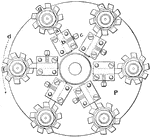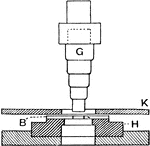Clipart tagged: ‘metalworking’

Twist Drills for Brass
"For brass or other soft metals there may be used with advantage a twist drill as shown. The cutting…

Old Persian Jar
This old Persian jar is made with a repousse copper technique. It is a metalworking technique shaped…

Relieving Milling Cutters Lathe
A face plate for milling on a lathe. The circular blades used for milling can be adjusted by using loosening…
Marking Gauge
A marking gauge is used in woodworking and metalworking to mark out lines for cutting or other operations.…

Stepped Hole Punch Tool
A stepped hole punch tool used to make holes in metal plates. The plate (B) is placed under the grip…